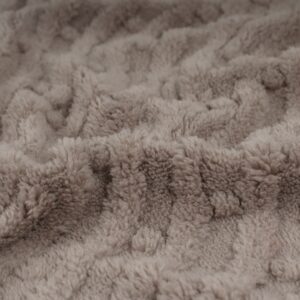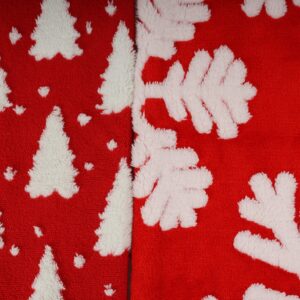Fleece fabric and Sherpa Fleece fabric are both warm and comfortable fabrics, and are also suitable for winter use, but there are differences between the two. This article will conduct an in-depth analysis of Fleece fabric and Sherpa Fleece fabric from multiple aspects such as raw materials, production process, main uses, and warmth retention. After reading this article, you will definitely understand the difference between Fleece fabric and Sherpa Fleece fabric.
What is Fleece fabric?
- Basic Definition
Fleece fabric is a type of textile made primarily from natural wool fibers through spinning, weaving, and finishing processes. Wool has long been a staple of high-end apparel and home textiles due to its excellent warmth retention, softness, and breathability. Wool’s core properties stem from its fiber structure—a scale-covered surface and a hollow interior that provides excellent heat retention and resilience.
- Historical Origins
The use of wool dates back thousands of years to pastoral civilizations. Records of herders shearing wool and processing it into felt, woolen cloth, and woolen fabrics can be found in the ancient Central Asian steppes, the European plateau, and the Middle East. In China, mature wool weaving techniques emerged as early as the Han Dynasty, and “Hu blankets” are mentioned in “Records of the Grand Historian.” With the opening of the Silk Road, wool products became a vital component of Eurasian trade, gradually influencing fashion and culture.
- Characteristics of Wool Fiber
Crimp: The natural crimp creates a large air space between fibers, enhancing thermal insulation. Hygroscopicity: Wool can absorb up to 30% of its own weight in water without feeling damp.
Elasticity: Wool returns to its original shape after stretching and is wrinkle-resistant.
Flame Retardancy: Naturally fire-resistant and non-flammable.
Dyeing Properties: Wool is rich in amino acids, which binds well to dyes and produces long-lasting color.
What is Sherpa Fleece fabric?
- Definition
Sherpa Fleece fabric, also known as “Sherpa fleece,” is a modern plush fabric developed to mimic the traditional wool clothing of the Tibetan Sherpa people. It features a curly, lambswool-like fleece on its surface and is typically made from polyester or a polyester/wool blend. It is popular for its lightness, thickness, and exceptional warmth. It is commonly used in winter clothing linings, coats, hats, blankets, pet supplies, and more.
2. Origin of the Name
The word “Sherpa” comes from the Sherpa people of the Himalayas, who have lived in the high-altitude, cold regions for generations and relied on thick wool clothing to protect them from the cold. The textile industry borrowed this name when developing new artificial wool in the 20th century, highlighting its “alpine cold-weather” qualities.
- Characteristics of Sherpa Fleece fabric
Realistic Appearance: Remarkably similar to real lambswool, with dense, curly down.
Soft Touch: Fine, fluffy surface, comfortable against the skin.
Excellent Warmth: Thick down provides excellent insulation.
Lightweight: Lighter than real wool, suitable for sportswear and casual wear.
High Abrasion Resistance: Polyester fibers are wrinkle-resistant and retain their shape.
Price Advantage: Lower cost than natural wool, suitable for large-scale applications.

Raw Material Sources
Sources of Fleece fabrics
Wool is primarily sourced from sheep, but its quality varies significantly depending on breed and origin:
Merino Wool: Known as the “Queen of Textile Fibers,” it boasts fine fibers and exceptional softness.
Highland Coarse Wool: Coarser fibers make it suitable for felt and carpets.
Longhair Wool: Lustrous and strong, it’s suitable for woolen cloth and coats.
Cashmere: Although often listed alongside wool, it is actually the finer down of goats (such as cashmere) and is therefore more valuable.
Wool is primarily harvested by shearing, which occurs annually in the spring. After cleaning and carding, it is ready for spinning.
Sources of Sherpa Fleece fabrics
Polyester: The most common fiber, derived from petrochemicals, offers low cost and stable performance.
Blended: Some Sherpa fabrics incorporate wool, acrylic, or cotton to improve breathability and feel. Recycled Polyester: In recent years, environmental trends have led to the increasing popularity of recycled polyester (rPET) made from discarded plastic bottles, giving Sherpa fabrics greater sustainability properties.
عملية الإنتاج
Fleece fabric Production Process
Raw Wool Sorting and Cleaning: Removes impurities, grease, and grass debris.
Combing or Combing: Depending on product requirements, woolen and worsted spinning are categorized as spinning. Woolen spinning is used for blankets and coats, while worsted spinning is used for suit fabrics.
Spinning: Wool fibers are stretched and twisted into yarn on a spinning machine.
Weaving: Fabric is formed using plain, twill, or other weave structures.
Dyeing and Finishing: Includes dyeing, milling, finishing, and moth-proofing.
Finished Product Inspection: Inspects weight, color fastness, width, and other indicators.
Process Characteristics: Complex procedures and high costs, but the fabric offers excellent performance and a natural feel.
Sherpa Fleece fabric Production Process
Fiber Preparation: Primarily polyester staple fiber or filament.
Knitting or Warp Knitting: Forms the base fabric layer. Raising: A fuzzy nap is created on the fiber surface using a card cloth or wire brush.
Trimming and shaping: The length and density of the fuzz are controlled to ensure a uniform appearance.
Dyeing and finishing: Antistatic, anti-pilling, or water-repellent treatments can be applied.
Process characteristics: The process is relatively simple, amenable to large-scale production, and chemical treatments can be used to improve performance.
Main Uses of Wool and Sherpa Fleece fabrics
Uses of Fleece fabrics
Due to its natural moisture absorption, warmth, and breathability, wool is widely used in high-end textiles and apparel. Its main uses include:
Apparel
Suits, suits, coats, and woolen jackets
Sweats, knitwear, and woolen sweaters
High-end scarves, shawls, gloves, and hats
Home Textiles
Blankets, carpets, and sofa covers
Mattress filling and mattresses
Industrial and specialty applications
Fireproof felt and anti-static fabrics
Musical instrument felt (piano hammer felt)
Felt materials for filtration
Fleece fabrics are often positioned in the mid- to high-end market, emphasizing quality and functionality.
2. Uses of Sherpa Fleece fabric
Sherpa fabric tends to target mass-market consumers, with its advantages being lightweight, thick, and cost-effective:
Apparel
Athleisure wear (sweatshirts, jackets, hoodies)
Winter coat linings (warmth layer)
Children’s clothing (popular for its softness and lightness)
Homewares
Blankets, throws, sofa blankets
Pet beds, pet clothing
Accessories and daily necessities
Boot linings, earmuffs, gloves
Stroller or baby sleeping bag linings
Sherpa Fleece fabric emphasizes accessibility, warmth, and comfort, making it particularly suitable for fashion items that need to be brought to market quickly.

Application Comparison
Applications of Fleece fabric
Business: Wool suits symbolize professionalism and class.
High-end fashion: Wool coats and shawls are often seen in luxury and designer collections.
Cold regions: Traditional blankets and bedding remain common in high-latitude countries.
Gifts and Collectibles: Wool scarves and sweaters are in strong demand as high-end gifts.
2. Applications of Sherpa Fleece fabric
Daily Leisure: Winter sportswear and light outdoor wear.
Student and Youth Market: Widely used by fast fashion brands due to its affordable price and fashionable styles.
Home Living: Blankets and pillows are popular among young people.
Fast-Moving Consumer Goods Market: Hot-selling items on cross-border e-commerce platforms, such as the Sherpa Blanket and Sherpa Hoodie.
Price Differences
Fleece fabric Prices
Ordinary wool: approximately 100-200 yuan/meter
Merino wool: 300-800 yuan/meter
Special varieties (such as cashmere blends): can reach over 1,000 yuan
Prices vary depending on the fineness of the wool, origin, and processing technology.
Sherpa Fleece fabric Prices
Polyester Sherpa: approximately 20-50 yuan/meter
Blended Sherpa (including wool and cotton): 50-100 yuan/meter
Overall, it is 25 times cheaper than natural wool, making it more suitable for the mid- to low-end mass market.
Comparison Summary: Fleece fabric is an “investment” item (expensive but durable), while Sherpa fabric is more of a “fast-moving consumer” item (affordable and quickly renews).
Warmth Comparison
Fleece fabric Warmth
The naturally curled structure of wool fibers creates air pockets that effectively trap body heat. It also offers excellent breathability, preventing stuffiness. In extremely cold conditions, a wool coat or blanket provides long-lasting warmth. Pros: Natural temperature regulation, providing warmth even in cold and damp conditions.
Cons: Heavy and slow to dry when wet.
Sherpa Fleece fabric Warmth
Sherpa wool, with its thick fleece layer, offers excellent insulation and provides immediate warmth.
Pros: Lightweight and thick, suitable for quick everyday warmth.
Cons: Slightly less breathable, can feel stuffy when worn for extended periods; less durable than wool in humid weather.
Conclusion: Wool excels in maintaining a constant temperature and comfort, while Sherpa wool excels in quickly keeping out the cold.
Durability: Is it prone to pilling and linting?
Fleece fabric
Pilling: Wool, due to its fine and soft fibers, is prone to pilling when rubbed, especially in knitwear. High-end worsted wool often incorporates anti-pilling treatments.
Lindding: Overall, linting is minimal, but new products may initially exhibit a small amount of loose lint.
Sherpa Fleece fabric
Pilling: Polyester fibers are relatively durable, but due to their fluffy surface, they can also pill over time.
Lindding: Low-quality Sherpa fabrics often shed and lint, while high-quality products improve this through shaping and finishing processes.
Comparative Summary: Wool is prone to pilling, while Sherpa fabrics are prone to linting. The former is due to “fiber friction,” while the latter is due to “process finishing.”
Summary:
In terms of usage, price, and performance:
Fleece fabrics: High-end, classic, and long-lasting, suitable for consumers who seek quality and a sense of status.
Sherpa Fleece fabrics: Lightweight and affordable, suitable for fast fashion and mass markets, meeting daily needs for quick warmth.
How to clean wool and Sherpa wool?
Cleaning Fleece fabrics
Wool fibers have a natural cuticle on their surface, which makes them susceptible to felting or shrinking when exposed to water. Therefore, special cleaning and care are required:
- Hand washing is preferred
Use warm water below 30°C to avoid shrinkage caused by high temperatures.
It is recommended to use a neutral detergent specifically for wool and avoid highly alkaline detergents.
- Gentle Cleaning Method
Do not scrub vigorously; instead, apply gentle pressure and kneading.
Do not wring out vigorously. It is best to lay the fabric flat on a towel to absorb moisture.
- Drying Instructions
Avoid direct sunlight to prevent the fibers from hardening and yellowing.
Lay the fabric flat to dry to preserve its original shape and prevent deformation.
Dry Cleaning is Suitable for High-End Fleece fabrics
High-end wool products such as suits and coats are more suitable for dry cleaning to prevent shrinkage and deformation.
Cleaning Sherpa Fleece fabrics
Sherpa fabric is primarily composed of polyester, making it easier to clean:
Machine Washing is Possible
Machine wash in cold or warm water, using the gentle cycle is recommended. Avoid high-temperature tumble drying to prevent the pile from collapsing.
Avoid strong alkalis and bleaching agents, as these can damage the polyester fiber structure and cause the pile to become brittle.
Shake to Restore Fluff: Gently shaking after washing helps restore softness.
Tumble dry on low heat if necessary to increase the fluffiness.
Comparative Summary: Wool requires “meticulous care,” while Sherpa is more “casual and easy to care for.”
How to Care for Wool and Sherpa Fleece fabrics?
Fleece fabric Care Tips
- Moth Control: Wool contains keratin, making it susceptible to moth attack. Store in a vacuum or with mothballs.
- Wrinkle Control: Avoid folding or pressing for long periods of time; hanging is best.
- Moisture Control: Keep wool products dry during storage. Excessive humidity can cause mold and mildew.
- Regular ventilation: Allowing wool products to breathe helps extend their lifespan.
Sherpa Fleece fabric Care Tips
- Anti-static: Dry environments attract dust easily; spray regularly with anti-static spray.
- Avoid Friction: Prolonged friction can cause the pile to collapse. Gently combing with a soft brush can restore fluffiness. Avoid high temperatures: Not suitable for baking or high-temperature ironing.
- Wash regularly: Easier to care for than wool, and can be washed more frequently with frequent use.
Is it environmentally friendly and sustainable?
The environmental friendliness of Fleece fabrics
- Natural fiber: Wool is a renewable resource, with sheep producing new wool every year.
- Degradable: Wool decomposes in the soil, releasing nutrients such as nitrogen and sulfur, making it environmentally friendly.
- Sustainability challenges: Large-scale sheep farming leads to land degradation and methane emissions, which are controversial issues for sustainable development.
- Solutions: Organic wool and traceable pasture certification (such as the RWS standard).
The environmental friendliness of Sherpa Fleece fabrics
- The main raw material is polyester: derived from petrochemicals and inherently non-degradable.
- Recycled polyester applications: More and more manufacturers are using rPET (polyester made from recycled plastic bottles) to reduce their carbon footprint.
- Durability: Long lifespan reduces waste frequency, another environmental advantage.
- Challenges: Microplastics may be released during washing, impacting water bodies. Comparative conclusion: Wool is naturally biodegradable, but it puts a heavy burden on the pastoral environment; Sherpa wool is synthetic, but its environmental properties can be improved through recycling technology.
A Comprehensive Summary of the Differences
The following table provides a visual comparison of the differences between wool and Sherpa fleece fabrics:
| Item | Fleece fabric | شيربا Fleece fabric |
| Raw Material | Natural wool fiber | Polyester / blended fibers |
| Manufacturing Process | Shearing, spinning, weaving, finishing | Knitting/warp knitting, brushing, heat setting |
| Main Uses | Suits, coats, premium scarves | Sportswear, blankets, home textiles, fast fashion items |
| الدفء | Thermoregulating, keeps warm even in damp or cold conditions | Thick and warm, lightweight but less breathable |
| Price | High (hundreds to thousands RMB per meter) | Low (tens of RMB per meter) |
| Pilling & Shedding | Prone to pilling | May shed fibers (especially in low-quality products) |
| Washing & Care | Requires gentle washing, preferably dry cleaning | Easy to wash, machine washable, low maintenance |
| Lifespan | Long (10+ years) | Moderate (3–5 years) |
| Eco-Friendliness | Natural, biodegradable | Synthetic, but can use recycled polyester (rPET) |
| Market Positioning | Mid-to-high-end, luxury | Mass market, fast-consumption |
الخاتمة
While wool and Sherpa wool share similar names, they are essentially representations of natural and man-made:
Wool symbolizes tradition, naturalness, and luxury. It is an investment fiber suitable for those seeking quality and long-lasting wear.
Sherpa fabric, on the other hand, represents the efficiency and affordability of modern industry, making it more suitable for fast fashion, everyday home furnishings, and mass consumption.
Consumer trends:
Younger consumers tend to choose Sherpa for its affordability, ease of care, and rapidly evolving styles.
Mature consumers continue to favor wool for its classic, comfortable, durable, and status symbolism.
In the future, with environmental trends and technological advancements:
The wool industry will increasingly shift towards sustainable animal husbandry and organic wool.
The Sherpa industry will continue to promote recycled polyester, low-carbon manufacturing, and improved functionality.
Ultimately, the two are not in a categorical relationship, but rather complement each other:
Wool meets high-end and traditional needs;
Sherpa meets the mass and fast-moving consumer market.



